-
Explain the following terms: (i) Share premium (ii) Rights issue
(Solved)
Explain the following terms: (i) Share premium (ii) Rights issue
Date posted:
November 16, 2018
.
Answers (1)
-
Atieno, Babu and Chesire have been trading in partnership sharing profits/losses in the ration of
5:3:2 respectively. On 1 April 2000 they admitted their manager, Dagana...
(Solved)
Atieno, Babu and Chesire have been trading in partnership sharing profits/losses in the ration of
5:3:2 respectively. On 1 April 2000 they admitted their manager, Dagana as a partner and the
profit sharing ratio was changed to 4:3:2:1 FOR Atieno, Babu, Chesire and Dagana respectively.
The partners valued the goodwill at Sh.510,000. Dagana paid Sh.200,000 as capital and his share
of goodwill, which should be based on capital contributions.
The partners do not wish to retain the goodwill account after admission of Dagana. The
admission of Dagana has not been fully recorded other than the cash receipt of Sh.376,500.
The following is the trial balance of the partnership as at 31 March 2001:
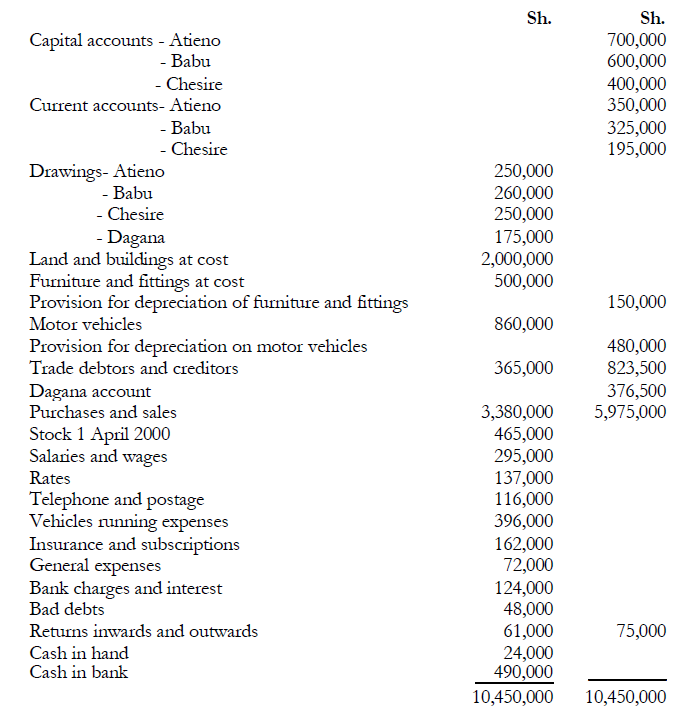
Notes:
1) Depreciation on furniture and fittings and motor vehicles is at 10% and 20% on reducing
balance respectively.
2) The closing stocks were valued at Sh.560,000.
3) Accrued salaries and wages and telephone bills amounted to Sh.24,000 and Sh.14,000
repectively.
4) Prepaid subscriptions and rates amounted to Sh.5,000 and Sh.25,000 respectively.
5) The partners decided that Dagana should be given a monthly salary of Sh.20,000 for the
whole year from 1 April 2000 to 31 March 2001.
6) Dagana took goods for own use at cost amounting to Sh.185,000. No entry has been made
in the books.
7) The old partners shared the cash paid by Dagana for part of his goodwill.
Required:
a) Trading, profit and loss account for the year ended 31 March 2001. (10 marks)
b) Partners capital accounts.
c) Partners current accounts.
d) Balance sheet as at 31 March 2001.
Date posted:
November 16, 2018
.
Answers (1)
-
Explain giving examples the distinguishing features of liabilities, provisions and reserves
(Solved)
Explain giving examples the distinguishing features of liabilities, provisions and reserves.
Date posted:
November 16, 2018
.
Answers (1)
-
Nzioka is a grocer who had not kept complete books of account. The following was a summary of his bank statements for the ear ended...
(Solved)
Nzioka is a grocer who had not kept complete books of account. The following was a summary of his bank statements for the ear ended 31 October 2000:
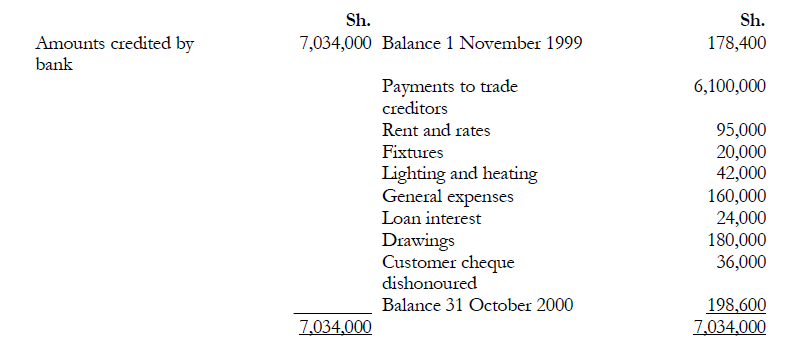
The following information is also available
1. Trading receipts consists partly of cash and party of cheques. During the year. Nzioka had
paid out of his cash takings wages amounting to Sh.590.000 and sundry expenditure of Sh
28.000. He retained Sh.600 a week (assume 52 ~weeks in a year) pocket money and
maintained a balance of Sh.4.000 in the till tot-change. The balance of his takings. together
with cheques amounting to Sh.50,000 which he had cashed out of his takings was paid into
the bank.
2. Cheque drawn payable to trade creditors. But not presented at I November 1999
amounted to Sh56000 and at 3I October 2000 Sh.64.000.
3. All dishonoured cheques were re-presented and honoured during the year.
4. The loan interest was paid to the lender who had lent Nzioka Sh.800.000 some years ago
at a rate of 3°o p.a. The interest was duly paid half-yearly on 31 January and 31 July and
the loan was still outstanding at the close of the year.
5. Discounts allowed by trade creditors amounted to Sh.96.000 and those allowed to debtors
were Sh. 104.000.
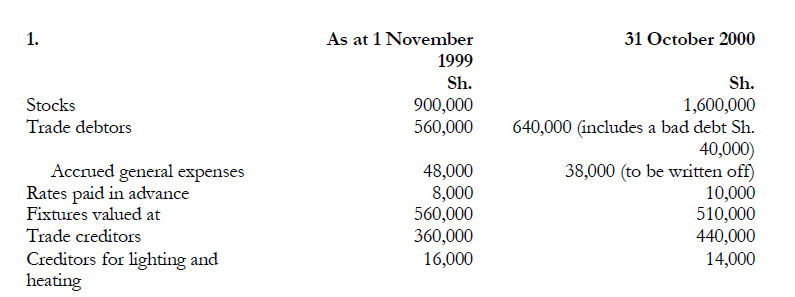
Required:
(a) A statement of Nzioka's capital on 1 November 1999.
(b) Profit and loss account for the year ended 31 October 2000 and a balance sheet at
that date.
Date posted:
November 16, 2018
.
Answers (1)
-
The following trial balance was extracted from the books of Literary and, Philosophical Society
as at 30 September 2000
(Solved)
The following trial balance was extracted from the books of Literary and, Philosophical Society
as at 30 September 2000:
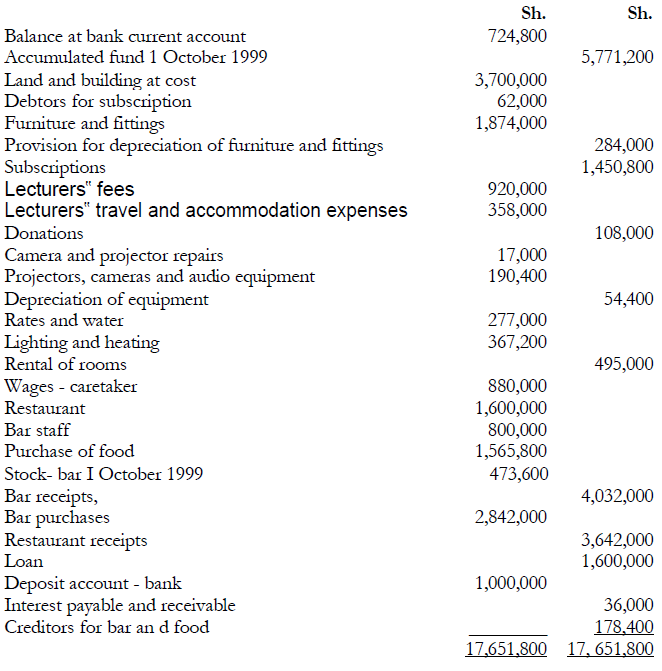
Additional information:
1: The bar stock was valued at Sh.642.800 as at 30 September 2000.
2. It is expected that of the debtors for subscriptions, Sh.43.600 will not be collectable.
3. The interest account is net. The loan is at a concessional rate of 4% while I0% has been
earned on the deposit account. No changes have taken place all year in the principal sums
involved.
4. An invoice for Sh.43.000 of wine had been omitted from the records at the close of the year
although the wine had been included in the bar stock valuation.
5.Depreciation for the rear is to be provided as follows: Furniture and fittings Sh. 194.000
Projectors. Cameras etc. Sh. 19.000
Required:
(a) Bar and restaurant trading account for the year ended 30 September 2000.
(b) An income and expenditure account for the year ended 30 September 2000.
(c) A balance sheet as at 30 September 2000.
Date posted:
November 16, 2018
.
Answers (1)
-
Munyah Ltd. is an expanding company and the following accounts relate to its operations for the years 1999 and 2000:
(Solved)
Munyah Ltd. is an expanding company and the following accounts relate to its operations for the years 1999 and 2000:
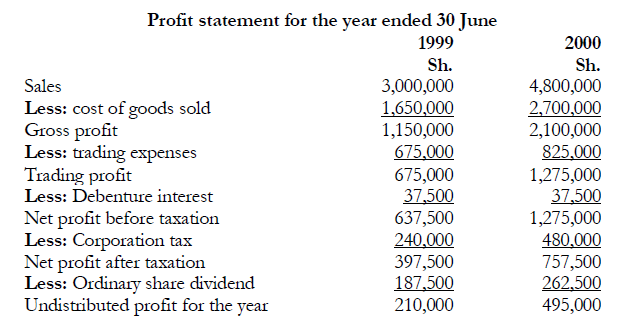
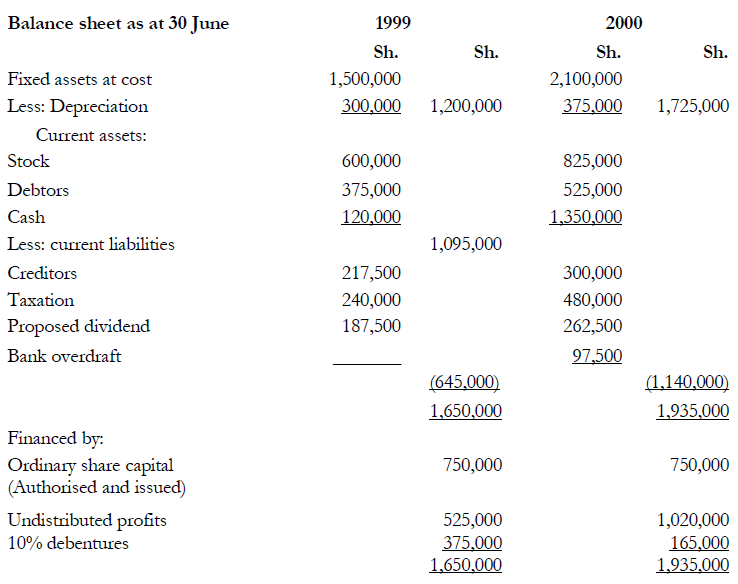
Required:
(i) Compute six accounting ratios for both 1999 and 200(1 which you feel would be of
particular value in assessing the Profitability and Liquidity of Munyah Ltd.
(ii) Comment on the current position of the company with the aid of the accounting ratios
computed in (i) above and any other information that you consider to be relevant.
Date posted:
November 16, 2018
.
Answers (1)
-
The following balances were extracted from the books of Wamu Traders Ltd.as at 30 September 2000
(Solved)
The following balances were extracted from the books of Wamu Traders Ltd.as at 30 September 2000:
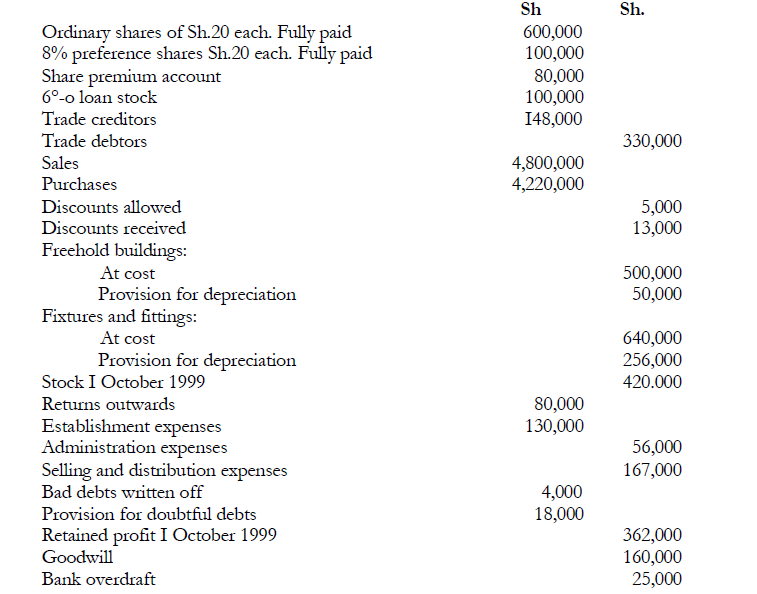
The following additional information is available:
1. Depreciation is provided annually on the cost of fixed assets held at the end of the
financial year at the following rate:
Freehold buildings 20%
Fixtures and fittings 10%
2. The trade debtors balance includes Sh. 10,000 due from Musa who has now been declared
bankrupt. In the circumstances, it has been decided to write the debt off as a bad debt.
3. The provision for doubtful debts as at 30 September 2000 is to be 5°,% of trade debtors
4. Establishment expenses prepaid at 30 September 2000 amounted to Sh.4,000.
5. Administration expenses accrued at 30 September 2000 amounted to Sh.7.000.
6. The company paid the interest on the loan stock for the year, ended 30 September 2000 on 30
October 2000.
7. Closing stock was valued at Sh.560,000.
8. The company's directors propose that the preference share dividend be paid and a
dividend of 10% the ordinary shares he paid.
Required:
(i) Trading and profit and loss account and appropriation account for the sear ended 30
September 2000 of Wamu Traders Ltd.
(ii) Balance sheet as at 30 September 2000.
Date posted:
November 16, 2018
.
Answers (1)
-
Briefly state the reasons why a company would not wish to distribute all its profits to its
shareholders
(Solved)
Briefly state the reasons why a company would not wish to distribute all its profits to its
shareholders.
Date posted:
November 16, 2018
.
Answers (1)
-
Two accounting concepts or conventions could clash or there could be
inconsistency between them.
Give two examples of such situations and explain how the inconsistency should be
resolved.
(Solved)
Two accounting concepts or conventions could clash or there could be inconsistency between them.
Give two examples of such situations and explain how the inconsistency should be
resolved.
Date posted:
November 16, 2018
.
Answers (1)
-
Define the following accounting concepts and for each explain their implication in the preparation of financial Statements.
(i) The Going concern concept.
(ii) Business entity concept.
(iii) Materiality.
(iv)...
(Solved)
Define the following accounting concepts and for each explain their implication in the preparation of financial Statements.
(i) The Going concern concept.
(ii) Business entity concept.
(iii) Materiality.
(iv) Realisation.
Date posted:
November 16, 2018
.
Answers (1)
-
Kamau and Kimani are partners sharing profits and losses in the ratio 3:2 respectively. The
partnership agreement provides for Kimani to receive a salary of Sh.4,000,000...
(Solved)
Kamau and Kimani are partners sharing profits and losses in the ratio 3:2 respectively. The
partnership agreement provides for Kimani to receive a salary of Sh.4,000,000 per annum, and
interest on capitals for both partners at 5% per annum. The partnership balance sheet as at 31
December 1998 was as follows:
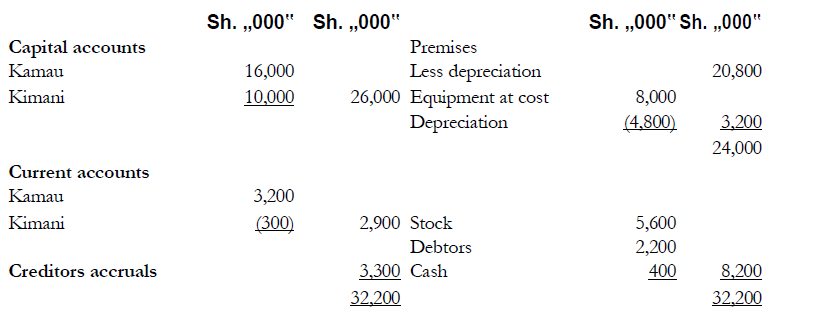
On I April 1999 Kimata was admitted to the partnership. He had been a salaried employee,
earning Sh.8, 000,000 per annum. The terms of his admission to the partnership were as
follows:
1. Kimata should introduce Sh. 12,000,000 in cash as capital into the business.
2. Goodwill should be valued at Sh.14, 000,000 for the purpose of his admission. It was
agreed that goodwill should not be included in the balance sheet of the new partnership.
3. Kimata should receive a salary as a partner of Sh.6 , 000,000 per annum.
Kimani's salary should be raised to Sh.6, 000,000.
4. Interest on capital should be raised from 5% to 6% per annum and calculated on the
capital accounts after the elimination of goodwill.
5. The new profit sharing ratio for Kamau, Kimani and Kimata should be 4:2:1
respectively.
In preparing the draft financial statements for the year ended 31 December 1999, the
partnership accountant, Otieno, calculated that the partnerships profit for the year was Sh.55,
155,000, and that the working capital of the business as at 31 December 1999 was:

Profit is assumed to accrue evenly during the year.
Partners cash drawings for the year were Kamau Sh.23,705,000, Kimani Sh.19,525,000 and
Kimata Sh.8,250,000.
Required:
(a) The profit and loss appropriation account for the year ended 3 1 December 1999.
(b) The current and capital accounts of the partners for the year ended 31 December
1999.
(c) Balance Sheet as at 31 December 1999.
Date posted:
November 16, 2018
.
Answers (1)
-
Mr. Ancentus Okwengo is the sole proprietor of a small business. The following trial balance
was extracted from his books at 31 March 2000.
(Solved)
Mr. Ancentus Okwengo is the sole proprietor of a small business. The following trial balance
was extracted from his books at 31 March 2000.
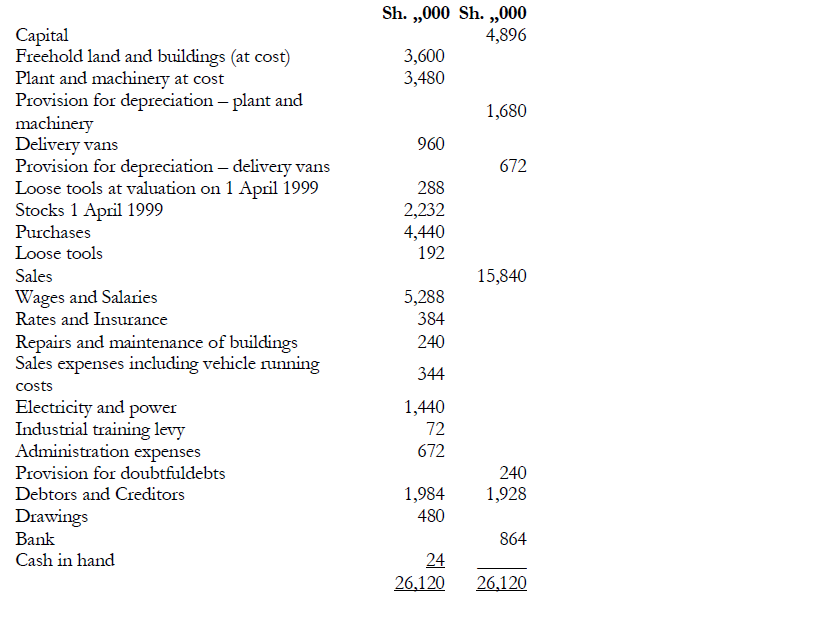
Additional information:
1. Closing stock on 3 1 March
2000 was Sh.2, 008,000.
Loose tools at valuation
Sh.384, 000.
2 .Provision is to be made for the following amount
owing on 3 1 March 2000: Electricity and power
Sh.192,000.
3. Payments in advance on 31 March
2000 were as follows: Van licenses
Sh.2,520 and rates Sh.13,800.
4. Depreciation on plant and machinery and delivery vans is to be provided at the rate of
20% and 25% respectively on cost at the end of the year.
5. Bad debts amounting to Sh.26,000 are to be written off and the provision for
doubtful debts is to be 10% of trade debtors.
Required:
A ten-column worksheet for the year ended 31 March 2000.
Date posted:
November 16, 2018
.
Answers (1)
-
The trial balance of Zach Ltd. as at 31 December 1999 was as follows:
(Solved)
The trial balance of Zach Ltd. as at 31 December 1999 was as follows:
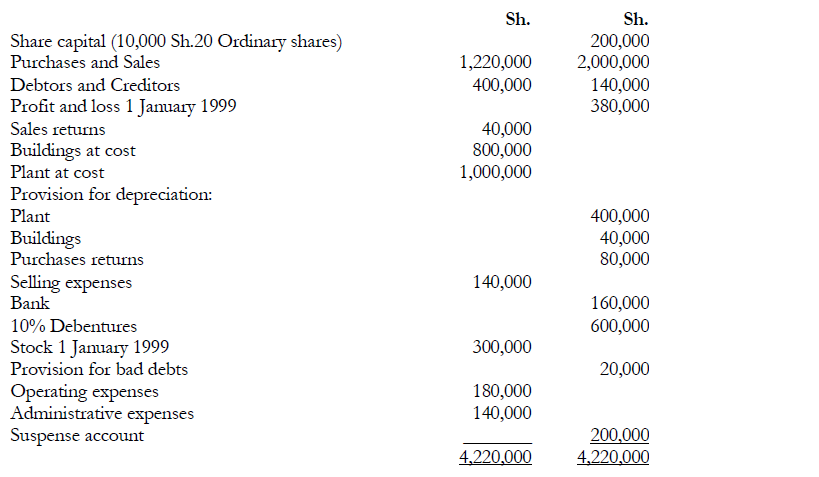
Additional information:
1. Stock at 31 December 1999 was Sh.360,000.
2. Sales returns of Sh.20,000 have been entered in the sales day book as if they were sales.
When this error was discovered, the debtors account had been corrected but the sales figure
was not rectified.
3. 5000 new shares were issued during the year at Sh.32. The proceeds have been credited to
the suspense account.
4. A fully depreciated plant which cost Sh.200,000 was sold during the year. No other entries except
bank have been made. The remaining balance on the suspense account after (2 and 3) above
represents the sale proceeds.
5. A debtor of Sh.20,000 has been declared bankrupt. A general provision is required at 5% of
debtors.
6. Rates of Sh.30,000 paid in December covering half year to 31 March 2000 have not been
entered in the books.
7. Debenture interest has not been paid.
8. Depreciation on plant is at 10% on cost and buildings at 2% on cost.
9. The directors propose to pay a dividend of Sh.2 per share and transfer Sh.20,000 to the
general reserve.
10. Corporation tax at a rate of 32'/2% on profits is estimated to be Sh.90,000.
Required:
(a)Suspense account for the year ended 3I December 1999
(b)Trading,profit and loss account for the year ended 31 December 1999.
(c) Balance sheet as at 31 December 1999.
Date posted:
November 15, 2018
.
Answers (1)